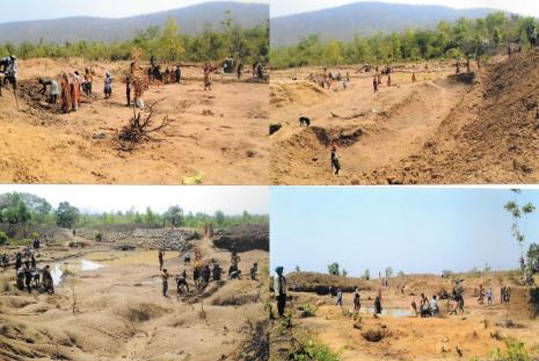
‘Odisha has many rivers, vast forest cover and it receives above average rainfall annually. But, greed for minerals beneath the land and destruction wreaked by industries hungry to exploit the resources of the state have slowly choked the natural environment of the state. Most farm holdings are small or marginal dependent on the rains for irrigation. The deficit rains in 2015-16 pushed the state over the edge. The state is facing extensive crop loss and severe water shortage.
The main purposes of the dam was envisioned as irrigation of the agricultural lands, vegetable & fish cultivation, plantation, forest protection, bathing and drinking of domestic & wild animals towards integrated development of the village and environment preservation.The check dam site and plan was finalised by the people and construction work began from December 2015, with villagers working in turns every Wednesday. Over 70 men & women contributed their labour towards the construction of the main dam and maintained an attendance register to keep track of this first phase of work. A total of 1440 man days of work were carried out by the villagers from December 2015 to June 2016. The work has been halted since June this year due to the rains. The water storage area will be about 30 acres and will irrigate more than 500 acres of agricultural land during the year. The water shall be supplied through 2 piped canals on either side without the usage of motor pumps.Secure agricultural prospects for a dignified lifeThe villagers are in the process of converting the barren lands into fertile agricultural land through this community initiative of courage and hard work. They are considering group cultivation to include economically or physically weak members of the village who will be unable to cultivate on their own. Discussions on experimenting with organic farming and horticulture gardens in the irrigated area have also taken place. The villagers have applied to the Block Development Officer of Parjang as well as the District Rural Development Agency and Collector of Dhenkanal for sanction of funds under MGNREGA for further construction of the watershed. In a positive response, funds have been assured by the authorities.ACS members have been actively involved in facilitating this commendable work and together with the villagers they have decided to organise a mega labour contribution day towards the project’s completion by involving all the activists and people from each village of ACS and its partner sangathan, Malyagiri Adivasi Sangharsh Manch, in January 2017. The experience has not only contributed a great deal to the confidence and self-reliance of villagers but also been a strong boost to the unity amongst villagers and sangathan. More such endeavours in community management of resources are being planned for a sustainable development plan that ensures a life of dignity and autonomy to the people.

